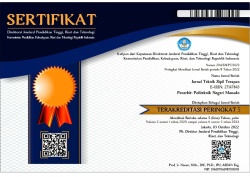Terakreditasi SINTA 5
General_Author_Guidelines
Author Guidelines for publication in JURNAL TEKNIK SIPIL TERAPAN (JTST)
- General Author Guidelines:
- The Manuscript should be written in Indonesian or English and have never been published or is not in the process of submission for publication to other media and does not contain elements of plagiarism.
- The Manuscript may take the form of research, case studies, or literary studies related to the Applied Civil Engineering.
- The author should register as an author. The guides to register and submit the paper is at the bottom.
- The submission file is in Microsoft Word file format with maximum 5000 words in 8-12 pages.
- The Manuscript should be prepared according to the following author guidelines and Template provided.
- Manuscript Preparation Guidelines:
Structure of the manuscripts
The body of manuscript should be structured by following the IMRaD format including Introduction, Methodology, Reasults and Discussions
- Title. The title should be short, clear, and informative, but does not exceed 20 words. It has to be pinpoint with the issues discussed. The article title does not contain any uncommon abbreviations. The main ideas should be written first and followed then by its explanations.
- Author’s names and institutions. The author's names should be accompanied by the author's institutions, institutions address, and email addresses, without any academic titles and job title.
- Abstract. The abstract should written in a single paragraph of about 200 words maximum. It is strongly encouraged the authors to use the following style of structured abstracts, but without headings: (1) Background: Place the question addressed in a broad context and highlight the purpose of the study; (2) Purpose of the Study: Identify the purpose and objective of the study; (3) Methods: Describe briefly the main methods or theoretical framework applied; (4) Results: Summarize the article's main findings; and (5) Conclusions: Indicate the main conclusions or interpretations.
- Keywords. List three to five pertinent keywords specific to the article; yet reasonably common within the subject discipline; use lower case except for names
- Introduction. The introduction should briefly place the study in a broad context and highlight why it is important. It should define the purpose of the work and its significance. Finally, briefly mention the main aim of the work and highlight the principal conclusions.
- Literature study. The state of the art of the research should be clearly discussed as a part of Introduction. The current state of the research field should be reviewed carefully, and key publications cited. Please highlight controversial and diverging hypotheses when necessary. References should be cited as (Caldarone, 2019) atau (Willar et al., 2006) atau (Putong, 2006; Rumbayan 2005). See the end of the document for further details on references. Technical terms should be defined. Symbols, abbreviations, and acronyms should be defined the first time they are used. All tables and figures should be cited in numerical order.
- Research method. The method contains an explanation of the research approach, subjects of the study, the conduct of the research procedure, the use of materials and instruments, data collection, and analysis techniques.
- Results and discussions. The results obtained from the research have to be supported by sufficient data. The research results and the discovery must be the answers, or the research hypothesis stated previously in the introduction part. Authors should discuss the results and how they can be interpreted from the perspective of previous studies and of the working hypotheses. The findings and their implications should be discussed in the broadest context possible. Future research directions may also be highlighted. The following components should be covered in the discussion.
- Conclusions. The conclusion should answer the objectives of the research and research discoveries. The concluding remark should not contain only the repetition of the results and discussions or abstract. You should also suggest future research and point out those that are underway.
- Recommendation. This part can be included in conclusions contains some recommendation that should be considered for future research development.
- Acknowledgments. In this section, you can acknowledge any support given. This may include administrative and technical support, or donations in kind (e.g., materials used for experiments).
- Conflicts of Interest. Declare conflicts of interest or state “The authors declare no conflict of interest.” Authors must identify and declare any personal circumstances or interests that may be perceived as inappropriately influencing the representation or interpretation of reported research results.
- References. The literature listed in the References contains only the sources referenced or included in the article. We recommend preparing the references with a bibliography software package, such as Mendeley and EndNote to avoid typing mistakes and duplicated references. Referral sources should provide 80% of journal articles, proceedings, or research results from the last ten years. Writing techniques bibliography, using the system cites APA (American Psychological Association) Style and the 6th edition.













